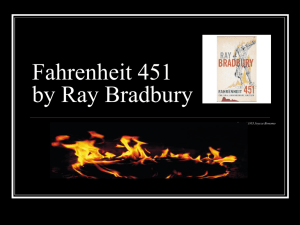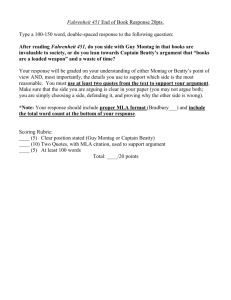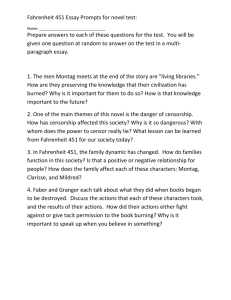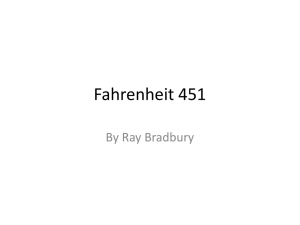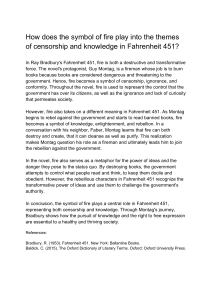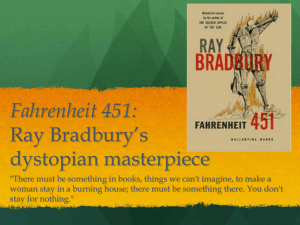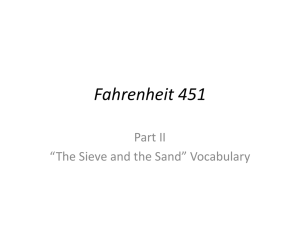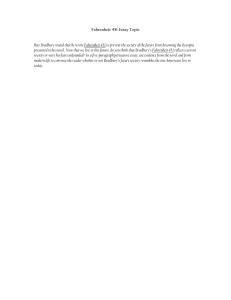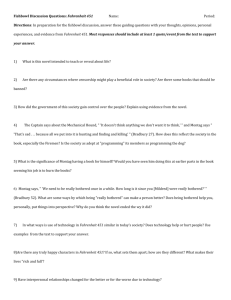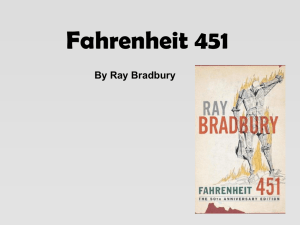F451 Intro - District 158
advertisement
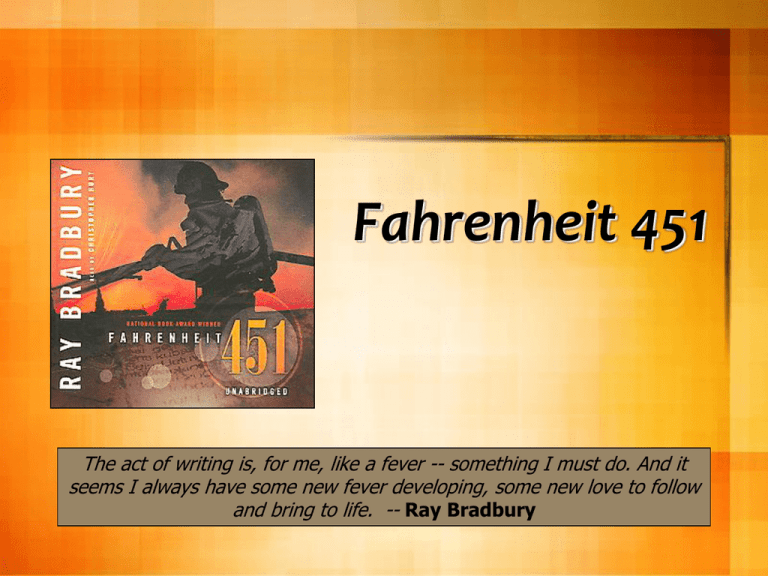
Fahrenheit 451 The act of writing is, for me, like a fever -- something I must do. And it seems I always have some new fever developing, some new love to follow and bring to life. -- Ray Bradbury 451 Settings & Conflicts Physical Setting – Sometime in 24th century – In and around unspecified city Social Setting – Two atomic wars since 1990 – Written words prohibited External Conflict: – Montag (rejects book burning) vs. Fire Captain Beatty (defends) Internal Conflict: – Montag accepting new world (violence/conformity) vs. Montag wanting old world (gentler/creative) Dystopia: an imaginary place or state in which the condition of life is extremely bad, as from oppression and/or terror. 451 Historical Context Written in 1950–1953, Los Angeles, CA – Futuristic, inspired by 1950’s reality – World War II recently ended – Middle class & consumerism rising – Era of McCarthyism – Threat of nuclear warfare loomed (Many Sci-Fi books and movies reflected this fear) Attack on Censorship Based on History – Future based on life Bradbury knew – Book burnings of Nazi regime and Soviet Union – Authors suppressed through statedirected writers' organizations. – Dissident writers were thrown into jails or exiled. 451 Character Names Guy Montag (Fireman/Protagonist) – Guy Fawkes? (English Revolutionary) – Name of a paper company Clarisse McClellan – Form of Clara, Latin for “bright” – Often associated with brightness different from a fire’s Professor Faber – Name of a pencil company Fire Captain Beatty – Insists society is ok 451 Structure Each chapter has a title that represents its theme 1: The Hearth and the Salamander 2: The Sieve and the Sand 3: Burning Bright We will explore this idea more as we read 451 Themes Self-expression is important and powerful. Violence is self-destructive. People lose their humanity when not able to personally interact with each other. Mindless pleasure seeking and materialism make for an empty life. Life is meaningless in a controlled, uniform society without imagination. Technology can isolate people and inhibit the sharing of ideas and emotions. In the wrong hands, modern technology can be dangerous. Without preserved knowledge of the past (books), a civilization dies or kills itself. Humanity can be reborn or revived. Censorship: the suppression of what is thought to be dangerous or offensive. Predict or Prevent? Bradbury claimed he was trying to “prevent the future,” not predict it. He did foresee future developments: – Walkmans, earbuds, big-screen and interactive TV, rise in violence, growing illiteracy, condensation of info into “sound bites” In F451, Bradbury satirizes: – Technology – Mass media – Organized sports – High-speed automobiles Fahrenheit 451 -- the temperature at which books begin to burn 451 Symbols Fire & Burning: destructive force at first; way to be warm in the end Blood: repressed spirit Water: baptism, rebirth, cleansing Unpleasant Insects/Animals: intrusive technology Mirrors: self-understanding Mechanical Hound: destructive technology not easily destroyed. (Demonstrates why people are better than machines.) Fahrenheit 451 -- the temperature at which books burn

